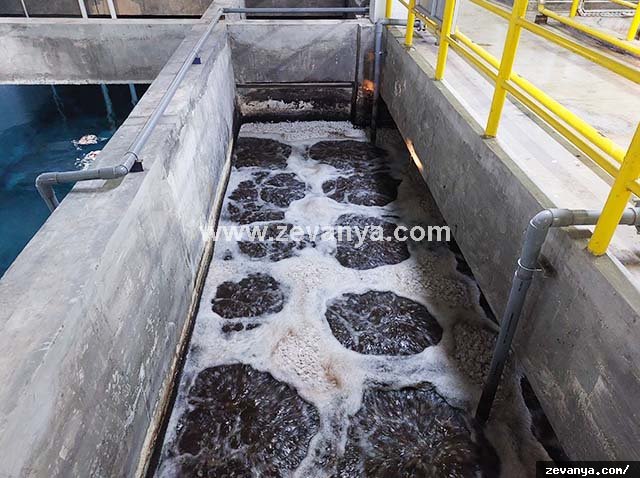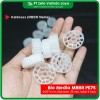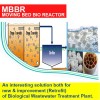Reducing COD and BOD Levels in Wastewater Using MBBR Moving Bed Biofilm Reactor
Reducing COD and BOD Levels in Wastewater Using the Moving Bed Biofilm Reactor (MBBR) Method

Wastewater treatment is crucial to ensure that industrial and municipal wastewater meets quality standards before being discharged into the environment. Among the various wastewater treatment technologies, the Moving Bed Biofilm Reactor (MBBR) is a popular choice due to its efficiency in reducing Chemical Oxygen Demand (COD) and Biological Oxygen Demand (BOD) levels. This article explores how the MBBR method works, the type of wastewater it treats, and why it is an effective solution for wastewater treatment.
What is MBBR?
The Moving Bed Biofilm Reactor (MBBR) is a biological wastewater treatment process that utilizes biofilm technology to degrade organic pollutants such as COD and BOD. Unlike traditional methods, MBBR is designed to maximize efficiency by providing a large surface area for biofilm growth using specialized media called carriers or biomedia, a small cylindrical plastic polypropylene pieces with diameters ranging from 10 to 25 mm and containing cavities. These carriers, suspended and constantly moving within the reactor, allow microorganisms to come into direct contact with the wastewater, enhancing the treatment process.
Types of Wastewater Entering the MBBR Reactor
Wastewater entering the MBBR reactor is typically pre-treated rather than raw wastewater. Pre-treatment processes can include:
- Grease Trap: Used to remove oils, fats, and other greasy substances that can interfere with the biological treatment process.
- Sedimentation: Involves allowing solids to settle out of the wastewater, which reduces the amount of suspended solids and improves the efficiency of the MBBR process.
- Primary Clarification: Removes large particles and organic solids to reduce the organic load entering the MBBR reactor. These pre-treatment processes help reduce the load of solids and oils, ensuring that the MBBR process focuses more on the degradation of dissolved organic matter, making it effective in reducing COD and BOD levels.
How MBBR Reduces COD and BOD Levels
- Understanding COD and BOD
- COD (Chemical Oxygen Demand) measures the total amount of oxygen required to oxidize organic and inorganic substances in water.
- BOD (Biological Oxygen Demand) indicates the amount of oxygen needed by microorganisms to biologically degrade organic matter in water.
High levels of COD and BOD in wastewater signify a high concentration of pollutants, which can be harmful to aquatic ecosystems if released untreated.
- MBBR Process
- Wastewater Inlet: Pre-treated wastewater enters the MBBR reactor or tank which contains thousands of media carriers (biomedia).
- Interaction with Carriers: The wastewater comes into contact with the moving carriers.
- Aeration: At the bottom of the reactor, diffusers create bubbles of air, which cause the carriers to move in all directions and prevent them from settling at the bottom. The movement generated by aeration also helps to mix the wastewater evenly and provides the oxygen needed for microorganisms to grow and carry out the degradation process.
- Biofilm Formation: Microorganisms grow and adhere to the surface of the carriers, forming a biofilm. This biofilm is crucial for breaking down organic pollutants.
- Effluent: The treated water, with significantly reduced COD and BOD levels, exits the reactor and is ready for further treatment if necessary.
- Mechanism of COD and BOD Reduction in MBBR
The reduction of COD and BOD in the MBBR system is primarily achieved through the action of the biofilm on the carriers:
- Biofilm Activity: The biofilm consists of various microorganisms, including bacteria, fungi, and protozoa, that thrive in the oxygenated environment of the MBBR reactor. These microorganisms use the organic matter in the wastewater as their food source.
- Degradation Process: As the wastewater flows through the reactor, organic pollutants are absorbed onto the biofilm's surface. Microorganisms within the biofilm then metabolize these pollutants, converting them into carbon dioxide, water, and biomass (new microbial cells).
- Reduction of COD and BOD: The breakdown of organic matter reduces the concentration of pollutants, leading to lower COD and BOD levels in the treated effluent. This process is continuous, with the biofilm constantly regenerating and maintaining its effectiveness as the carriers move within the reactor.
Benefits of the MBBR Method
- High Efficiency: The MBBR system is highly effective in reducing COD and BOD levels, making it ideal for various industries.
- Compact Design: The system's compact nature allows it to be integrated into existing facilities without requiring much space.
- Low Sludge Production: Compared to traditional methods, MBBR produces less sludge, reducing the burden of sludge management and disposal.
The Moving Bed Biofilm Reactor (MBBR) method is a proven and effective solution for reducing COD and BOD levels in wastewater. Its ability to handle high organic loads, combined with its compact design and low sludge production, makes it a preferred choice for industries aiming to meet stringent environmental regulations.



